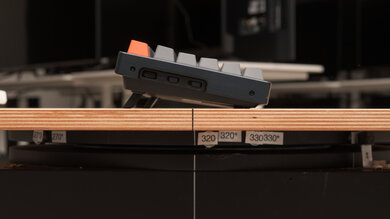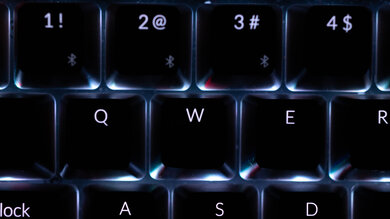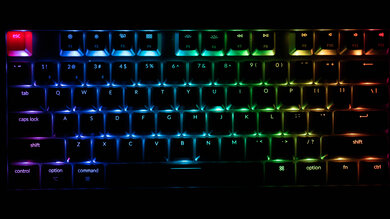The Keychron K8 is a wireless mechanical keyboard that is essentially a TenKeyLess (80%) version of the Keychron K4. Our unit uses Gateron Brown switches, which offer tactile feedback without causing too much noise, making it a good fit for office use. That said, you can also purchase this keyboard with Gateron Red or Blue switches. Unfortunately, it doesn't have any macro-programmable keys or any companion software, which may be a disappointment to gamers and programmers. This keyboard may be difficult to find through online retailers, but you should be able to easily purchase one from the Keychron website.
Our Verdict
The Keychron K8 is a good keyboard for gaming. The Gateron Brown switches in our unit don't need much force to actuate, resulting in a light and responsive gaming experience. Also, build quality is excellent, with a solid frame and stable keycaps. Unfortunately, there's no companion software or macro-programmable keys.
- Full RGB backlighting.
- Great typing quality.
- Sturdy build.
- Very responsive.
- No macro-programmable keys.
- No companion software.
- No wrist rest.
The Keychron K8 is an adequate keyboard for use with your smartphone or tablet. You can connect it wirelessly with Bluetooth and pair it with up to three devices simultaneously. Unfortunately, it's rather large and heavy, making it inconvenient to travel with.
- Multi-device pairing.
- Bluetooth support.
- Large and heavy.
The Keychron K8 is a good keyboard for office use. The unit we tested uses Gateron Brown switches, which offer great typing quality due to the quiet and tactile feedback. The keyboard itself is made of solid plastic and the keys feel stable. Unfortunately, the ergonomics are only okay, as the high profile can lead to some fatigue or pain with prolonged use and there's no wrist rest included.
- Great typing quality.
- Sturdy build.
- No wrist rest.
The Keychron K8 is a good keyboard for programmers. The unit we tested uses Gateron Brown switches, which offer great typing quality due to the quiet and tactile feedback. The build quality is excellent, as it's made of plastic that feels durable and the keys feel stable. Unfortunately, the ergonomics are only okay, as the high profile can lead to fatigue with prolonged use and there's no wrist rest.
- Full RGB backlighting.
- Great typing quality.
- Multi-device pairing.
- Bluetooth support.
- Sturdy build.
- No macro-programmable keys.
- No companion software.
- No wrist rest.
The Keychron K8 is okay for use with a home theater PC. It has wireless connectivity so that you don't need to run a cable from the couch to the computer. However, it lacks a trackpad for navigation. It has backlighting for those who like to watch TV in the dark, and media controls are easily accessible through hotkeys.
- Full RGB backlighting.
- Great typing quality.
- Bluetooth support.
- No companion software.
- No trackpad.
Changelog
- Updated Jan 26, 2022: Following our most recent test bench update, some of the scores for this keyboard were changed, but none of our language within the review was revised. We've now updated several adjectives which corresponded incorrectly to their scores.
- Updated Feb 04, 2021: Converted to Test Bench 1.0.
- Updated Jan 04, 2021: Updated the Build Quality score.
- Updated Sep 28, 2020: Review published.
Check Price
Differences Between Sizes And Variants
We tested the Keychron K8 Wireless with an aluminum frame, RGB backlighting, and Gateron Brown switches. There's a variant with a plastic frame, which you can get with white or RGB backlighting. You can also get the keyboard with Gateron Blue or Red switches, or hot-swappable Gateron or Keychron Optical switches, making it easier to change switches if you want to. You can see the label of our unit here.
Popular Keyboard Comparisons
The Keychron K8 is a TenKeyLess (80%) keyboard that performs almost identically to the Keychron K4, a compact (65%) keyboard that doesn't have a Numpad or arrow keys. It's also similar to the compact 96% Keychron K6, except that one has a full Numpad. The K8 is available in a wide variety of switches and comes in hot-swappable versions that allow you to easily change switches without soldering. The K8 also features a wireless design that helps keep desk clutter to a minimum. For other options, you can also check out our recommendations for the best gaming keyboards, the best wireless keyboards, and the best mechanical gaming keyboards.
The Keychron K2 (Version 2) and the Keychron K8 are essentially the same keyboard in two different sizes. The K2 is 75%, while the K8 is 80%. The K2 is available with various Gateron switches, but the K8 has both Gateron and Keychron Optical switch options. That said, both keyboards have a hot-swappable variant that lets you change the switches without soldering. Latency is better on the K8, but the difference shouldn't be noticeable to most people.
The Keychron K8 and the Keychron Q3 are both TKL-sized mechanical keyboards designed for office use. Both keyboards are hot-swappable, though the K8 requires you to purchase that specific variant. This means you can change out the stock switches for any you want without soldering. However, they have a few differences. The K8 is wireless and pairs with up to three devices simultaneously. On the other hand, the Q3 is wired-only, but it has better latency, and all keys are macro-programmable as it has companion software, which the K8 lacks.
The Keychron K4 is essentially a full-size version of the Keychron K8. There are some small differences, though, The K8 feels better built, and it offers two incline settings, whereas the K4 only has one. The K8 uses Gateron switches, but you can also get it with Keychron Optical switches, and it has a hot-swappable version that lets you change the switches without soldering. The K4 is available with various LK Optical or Gateron switches.
The Keychron K8 is a larger version of the Keychron K6. The K8 is a TenKeyLess (80%) keyboard, while the K6 is 65%; both keyboards are available with Gateron or Keychron Optical switches. If you plan on using it for gaming, the K6 has lower latency, although you have to use it wired.
Test Results

The Keychron K8 is a wireless, TenKeyLess (80%) keyboard that shouldn't take up too much space at your desk. If you want a more compact model, check out the 60%-sized Keychron K12, and if you prefer a full-size version, look into the Keychron K10.
The Keychron K8 has excellent build quality. It has an aluminum frame that feels very solid and doesn't flex at all. The keycaps are made of ABS plastic; they feel decent but are fairly slick and prone to attracting oil from your fingers, making them even slippier. The keys wobble just a bit, but it isn't that bad. However, there's an upgraded version of this keyboard as part of the Keychron K Pro Series lineup, which features a better build quality with PBT keycaps.
The Keychron K8's ergonomics are only okay. It has two incline settings, which can help make typing more comfortable, depending on your preference. Unfortunately, it doesn't include a wrist rest, and its high profile may cause some pain or fatigue with prolonged use.
The Keychron K8 has outstanding RGB backlighting. You can cycle through various presets by pressing the 'Light Bulb' button on the top right of the board. Unfortunately, even in a brightly lit room, the backlight isn't that bright, as most of the RGB lighting shines through the space around the keycaps rather than through the keycaps themselves. There are versions with white backlighting and an aluminum frame, one with RGB backlighting, but we haven't tested them.
This keyboard comes with a short detachable, braided USB-C cable that retains some of the packaging kinks.
This keyboard has wireless capabilities. It connects through Bluetooth and pairs with up to three devices at the same time. It's powered by a rechargeable battery, and you can use the board as you charge it.
This keyboard doesn't have too many extra features. It lacks any macro-programmable or dedicated media keys and instead uses media hotkeys. The user manual mentions that you can remap the keys through recommended third-party software, but since it's not first-party software, we don't test this. If you want a keyboard with macro-programmable keys and the software to set them, consider the Durgod Taurus K320.
Our unit has Gateron Brown switches. If you don't like the feeling of the Brown switches, you can also choose between Red or Blue switches, which are linear and quiet, or clicky and tactile, respectively. The Brown switches require minimal amount of force to actuate, which makes the typing experience feel very light. The pre-travel is short, making the keyboard feel responsive. If you want a TKL keyboard that's also hot-swappable, so you can swap out the stock switches, check out the Keychron Q3.
The Gateron Brown switches in our model provide a great typing experience. The switches' pre-travel distance is high enough to not cause accidental typos but low enough to still feel responsive. Also, it doesn't feel tiring to type on, and the keycaps are solid and well-spaced out. That said, the keycaps can be rather slippery due to the ABS plastic and will attract oil from your fingertips.
The latency is decent. The Bluetooth latency is fine for general desktop use, but if you're planning to game with it, it's better to use it wired.
Unfortunately, the Keychron K8 doesn't have software support. The user manual mentions that you can remap the keys through third-party software, but as it's not officially supported, we haven't tested this. If you want a keyboard that has software for customization, check out the Razer Huntsman Tournament Edition.
The Keychron K8 has very good compatibility. Note that the key for the question mark and slash symbols didn't work for us on any platform, which brought the overall score down. This may be a manufacturing issue, but we have no way of knowing for sure. It's fully compatible with Windows, with only the brightness buttons not working on macOS and the function keys not working as intended on Linux. Also, the F3 and F4 buttons don't work on iOS and iPadOS.









